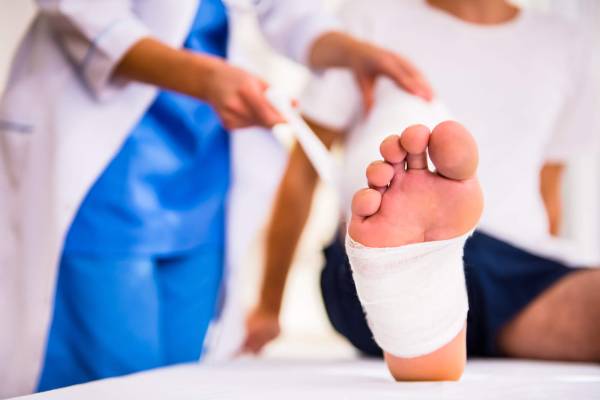Department of Diabetic Foot Treatment
Foot problems in a person with diabetes are one of the most common complications seen in India. Although intensive efforts need to be made to avoid these foot complications, it is more easily said than done, especially in our country where walking barefoot is much more common than in the West. The reality is such that often the presenting complaint of a person with diabetes is a major foot infection, often with nonhealing ulceration.
Dr. Sachin Khade at Dr. Khade Super Speciality hospital in Chakan, Pune provides diabetic foot treatment at an affordable cost. It has been shown that after accidents, diabetes-associated foot problems are the second most common cause of lower-limb amputations in Chakan, Pune. Patients with diabetes mellitus may present to the diabetes mellitus may present to the primary care practitioner with dangerous lower-extremity sequelae that are extremely challenging to treat

How Can Diabetes Affect My Feet?
Diabetes can cause two problems that can affect your feet:
- Diabetic neuropathy: Uncontrolled diabetes can damage your nerves. If you have damaged nerves in your legs and feet, you might not feel heat, cold, or pain there. This lack of feeling is called “sensory diabetic neuropathy.” If you do not feel a cut or sore on your foot because of neuropathy, the cut could get worse and become infected.
- Peripheral vascular disease: Diabetes also affects the flow of blood. Without good blood flow, it takes longer for a sore or cut to heal. Poor blood flow in the arms and legs is called “peripheral vascular disease.”
Signs of Diabetic Foot Problems
If you have diabetes, contact your doctor if you have any of these problems:
- Changes in skin color
- Changes in skin temperature
- Swelling in the foot or ankle
- Pain in the legs
- Open sores on the feet that are slow to heal or are draining
- Ingrown toenails or toenails infected with fungus
- Corns or calluses
- Dry cracks in the skin, especially around the heel
- Foot odor that is unusual or won’t go away
What Are Some Common Foot Problems With Diabetes?
- Skin and bone infections: A small cut or wound can lead to infections. Nerve and blood vessel damage, along with immune system problems, make them more likely. Most infections happen in wounds previously treated with antibiotics. Infections can be treated with antibiotics. Severe cases may require treatment in a hospital.
- Abscess: Sometimes infections eat into bones or tissue and create a pocket of pus called an abscess. The common treatment is to drain the abscess. It may require the removal of some bone or tissue, but newer methods, like oxygen therapy, are less invasive.
- Gangrene: Diabetes affects the blood vessels that supply your fingers and toes. When blood flow is cut off, tissue can die. Treatment is usually oxygen therapy or surgery to remove the affected area.
- Deformities: Nerve damage can weaken the muscles in your feet and lead to problems like hammertoes, claw feet, prominent metatarsal heads (ends of the bones below your toes), and pes cavus, or a high arch that won’t flatten when you put weight on it.
Dr. Sachin Khade Tips for Diabetic Foot Care:
Proper foot care can prevent these common foot problems or treat them before they cause serious complications. Dr. Sachin Khade can give some tips on foot care:
- Take care of yourself and your diabetes. Follow Dr. Sachin Khade’s advice regarding nutrition, exercise, and medication. Keep your blood sugar level within the range.
- Wash your feet in warm water every day, using a mild soap. Test the temperature of the water with your elbow because nerve damage can affect sensation in your hands, too.
- Check your feet every day for sores, blisters, redness, calluses, or any other problems. If you have poor blood flow, it is especially important to check your feet daily.
- If the skin on your feet is dry, keep it moist by applying lotion after you wash and dry your feet. Do not put lotion between your toes.
- Gently smooth corns and calluses with an emery board or pumice stone. Do this after your bath or shower, when your skin is soft.
- Check your toenails once a week. Trim your toenails with a nail clipper straight across. Do not round off the corners of toenails or cut down on the sides of the nails.
- Always wear closed-toed shoes or slippers. Do not wear sandals and do not walk barefoot, even around the house.
- Always wear socks or stockings. Wear socks or stockings that fit your feet well and have soft elastic.
- Wear shoes that fit well. Buy shoes made of canvas or leather and break them in slowly.
- Always check the inside of shoes to make sure that no objects are left inside.
Diabetic Foot Treatment in Chakan?
Treatment for diabetic foot problems varies according to the severity of the condition. A range of surgical and nonsurgical options is available.
Nonsurgical treatment
Dr. Sachin Khade will first attempt to treat diabetic foot problems without using surgery. Some methods include:
- keeping wounds clean and dressed
- wearing immobilization devices, such as a cast boot or total contact cast
- closely observing any gangrene on the toes until self-amputation occurs, which is when the toes fall off due to lack of blood flow
Surgical treatment
When non-surgical treatment does not successfully heal diabetic foot problems, the doctor might consider surgery. Surgical options include:
- the removal of decaying or dead tissue
- amputation, ranging from single toes or sections of the foot to amputation of the leg below or even above the knee
- surgical stabilization of Charcot’s Foot
- an arterial bypass for peripheral vascular disease, which assists blood flow to the area
- endovascular surgery with placement of stents, which uses small devices to keep blood vessels open
What Our Patients Say
Ashok Chavan
Patient
Dr. Sachin is so professional and gives a personal touch which helps the patients to feel more cared. He has a great experience and really helped me to control my hypertension with so much ease.
Uday Shinde
Patient
We have personal experience of getting excellent treatment in time of sick-health, his taking care of patients, advice and treatment are outstanding.
Sonali Bombale
Patient
Dr. Sachin is a very knowledgeable and experienced doctor. He listens to the patient patiently . And guide them properly .


